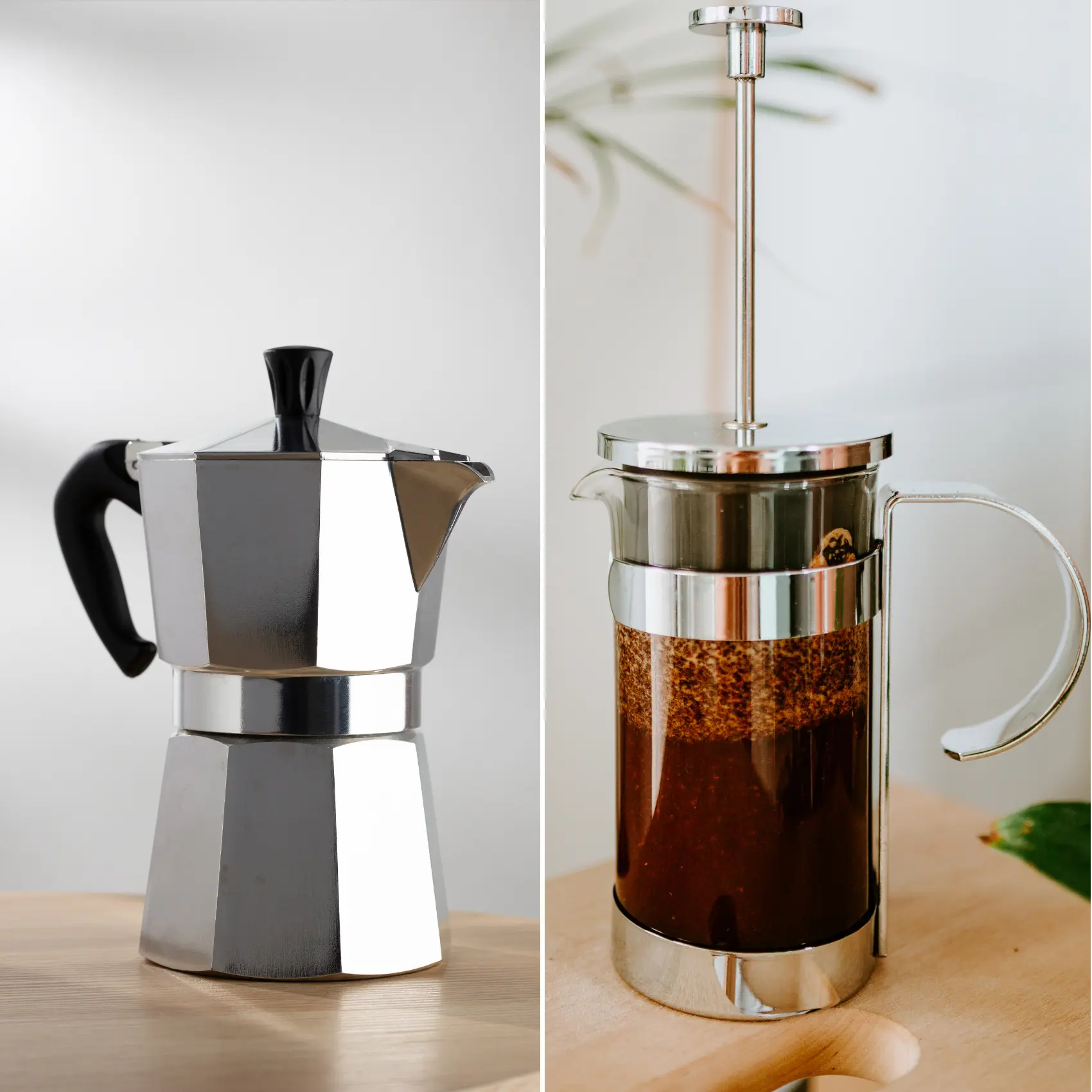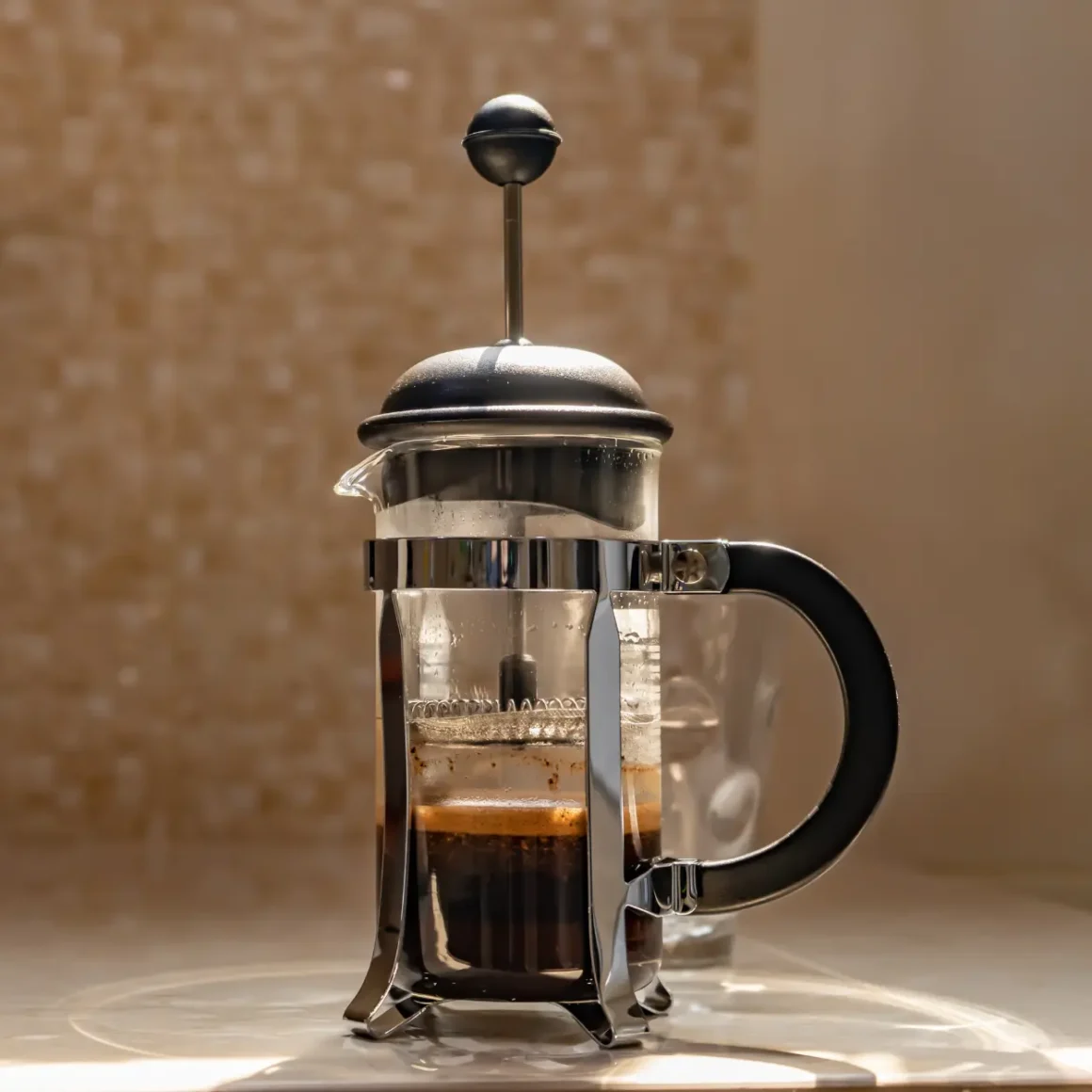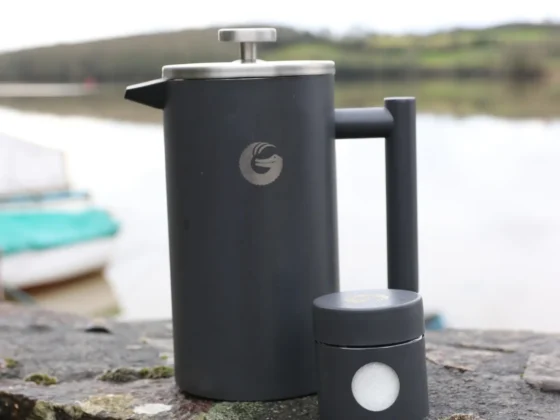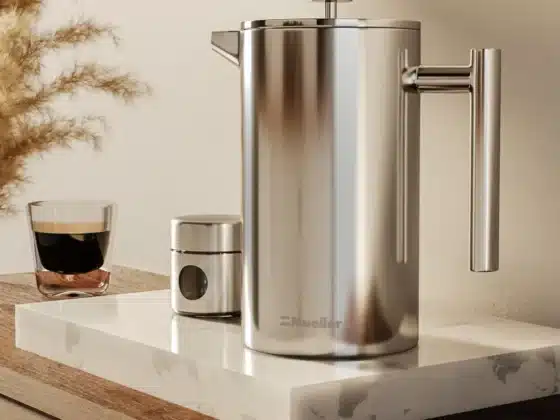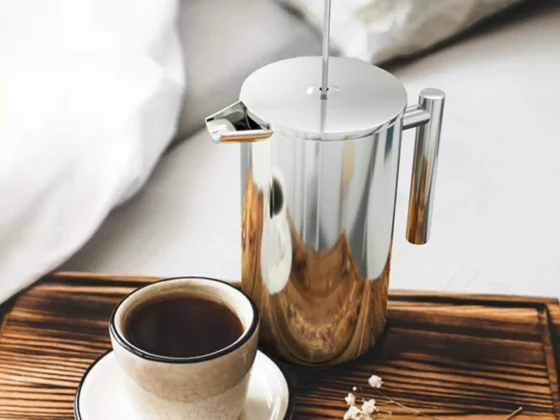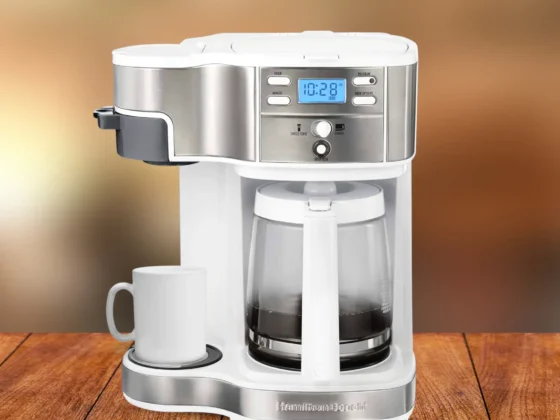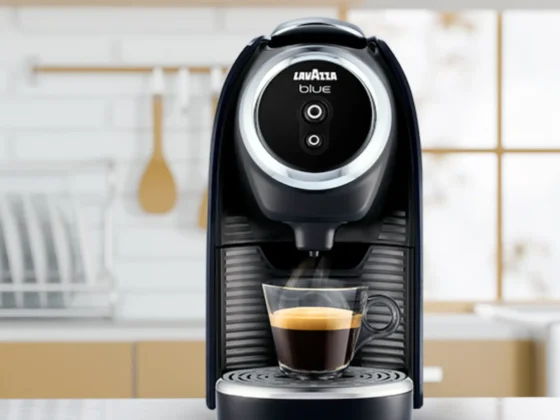For every coffee aficionado, the quest for the perfect brew often leads to a crossroads: Moka pot vs French press. Both, with their rich histories and distinct brewing profiles, present a delightful yet challenging dilemma for coffee lovers. As we journey into the depths of these two revered methods, we aim to shed light on their unique attributes, helping you navigate this delightful dilemma and discover which brew truly resonates with your coffee soul. Join us in this exploration of these exquisite coffee makers, and find out where your coffee heart truly lies.
Not in the mood for reading? Tune in to the audio version of the article below.
- Introduction & Key Takeaway
- https://app.mysoundwise.com/tracks/16980121518501030e.mp3
- What is a Moka Pot?
- https://app.mysoundwise.com/tracks/16980121723978699e.mp3
- What is a French Press?
- https://app.mysoundwise.com/tracks/16980121975891775e.mp3
- Flavor and Aroma Comparison
- https://app.mysoundwise.com/tracks/16980122207553999e.mp3
- Moka Pot vs French Press: Brewing Tips
- https://app.mysoundwise.com/tracks/16980122466656174e.mp3
- Anatomy of a Moka Pot: Aluminum vs. Stainless Steel
- https://app.mysoundwise.com/tracks/16980122719960771e.mp3
- French Press Components: Glass vs. Stainless Steel
- https://app.mysoundwise.com/tracks/16980123006378291e.mp3
- Care and Longevity: Tips for a Lasting Coffee Relationship
- https://app.mysoundwise.com/tracks/16980123261404929e.mp3
- Moka Pot vs French Press: Making Your Choice
- https://app.mysoundwise.com/tracks/16980123544199480e.mp3
- Conclusion & FAQs
- https://app.mysoundwise.com/tracks/16980123922899590e.mp3
French Press vs Moka Pot: Key Takeaway
- Flavor Foundations: The French Press is renowned for a rich, full-bodied brew, letting coffee’s natural oils shine. On the other hand, the Moka Pot promises an espresso-like intensity, capturing the deeper essence of coffee beans. Your flavor preference will play a pivotal role in your choice between the two.
- Brew Time Breakdown: While the French Press requires a 4-5 minute immersion steeping, the Moka Pot can vary from 5-10 minutes based on factors like heat and pot size. It’s essential to factor in how much time you’re willing to dedicate to your brewing ritual.
- Portability Perks: The French Press, especially in its stainless steel or plastic avatars, is a traveler’s companion. In contrast, the compact and lightweight nature of smaller aluminum Moka Pots ensures they’re equally travel-friendly. Depending on your journey, one might prove more convenient than the other.
- Beginner’s Best Bet: For novices, the French Press offers a straightforward, almost fail-safe method. The Moka Pot, while not overly complex, does require a tad more attention to detail. Your comfort level with brewing techniques might just dictate your preference.
- Mistakes to Minimize: With the French Press, it’s crucial to ensure coarser grinds and an even plunge to avoid over-extraction. The Moka Pot, meanwhile, demands vigilance with grind size and heat application to sidestep burnt brews. Knowledge of these common pitfalls can elevate your coffee experience, irrespective of the method chosen.
What is a Moka Pot?
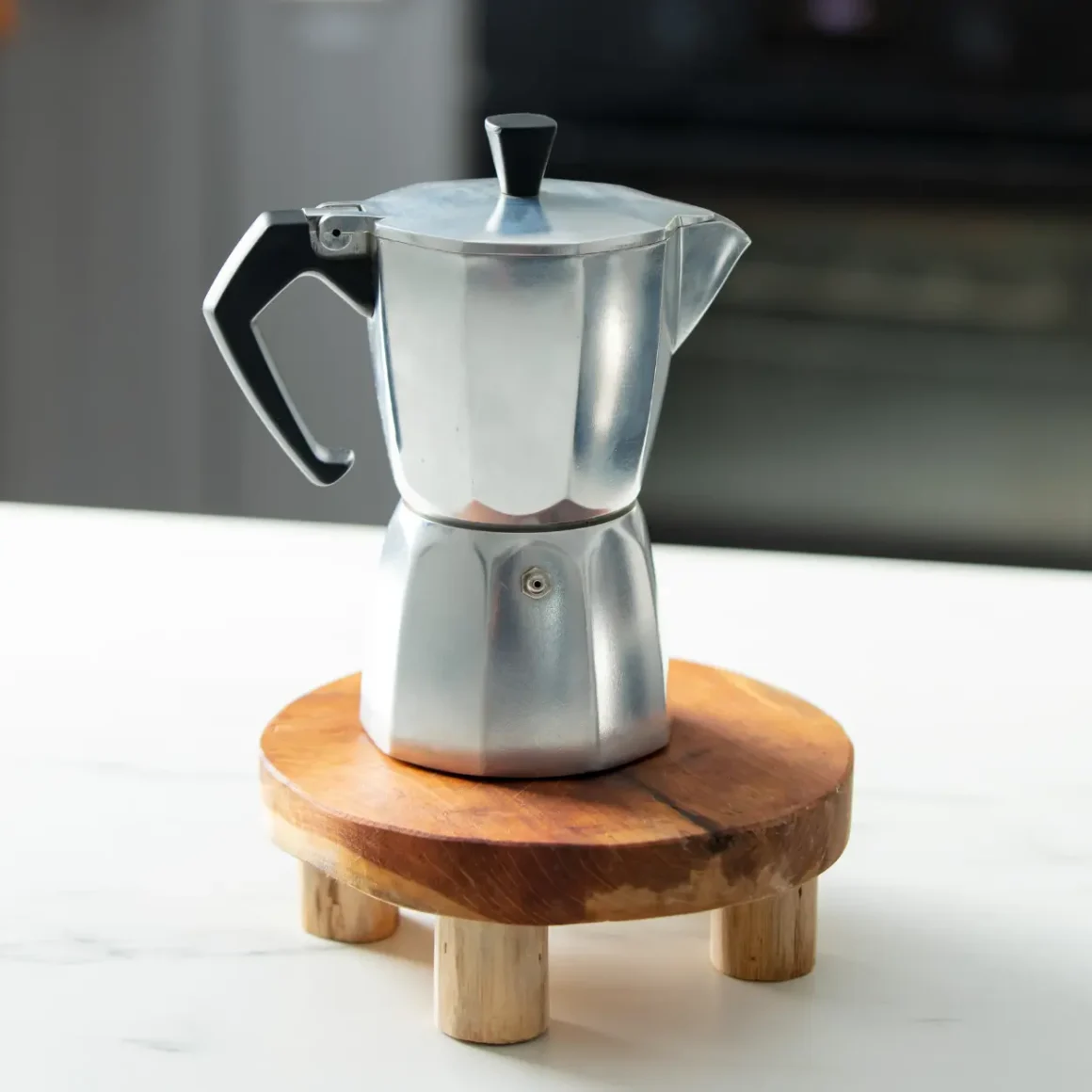
A Moka Pot is a traditional Italian stovetop coffee maker designed to brew coffee by passing boiling water pressurized by steam through ground coffee. It was invented in the early 1930s by Luigi Di Ponti and has since become a staple in many households, particularly in Europe. (1) This coffee pot provides an approach that’s halfway between an espresso machine and a traditional drip coffee method. It’s known for producing a rich, full-bodied cup of coffee, often referred to as moka pot coffee.
The Anatomy of a Moka Pot
The classic design of this coffee maker consists of an octagonal shape and is made primarily of aluminum or stainless steel. Understanding its anatomy is essential for anyone pondering how to use a Moka pot.
Moka Pot Components:
- Bottom Chamber: This section holds the water that will be brought to a boil. It has a safety valve on the side to release any excess pressure.
- Filter Funnel: Placed on top of the bottom chamber, it holds the coffee grounds. The fine texture of the filter ensures that only brewed coffee, not grounds, makes its way to the top.
- Top Chamber: This is where the brewed coffee ends up. As boiling water from the bottom chamber is forced through the coffee grounds, it travels up and collects here.
- Gasket and Filter Plate: These ensure a tight seal between the top and bottom chambers and prevent any grounds from ending up in the brewed coffee.
How to use a Moka Pot:
- Water Filling: Begin by filling the bottom chamber with water, just below the safety valve.
- Adding Coffee: Place finely ground coffee into the filter funnel, ensuring it’s evenly spread but not pressed down too tightly.
- Assembling and Brewing: Screw the top and bottom chambers together and place the coffee pot on a stovetop on low to medium heat. In a few minutes, you’ll hear a bubbling sound, which indicates that coffee is starting to flow into the top chamber.
- Completion: Once the bubbling sound diminishes and the top chamber is full, remove the coffee pot from the heat. Your coffee is now ready to be poured.
Pros and Cons of Using a Moka Pot
The Moka Pot is a cherished coffee brewing method with a rich history. For many, it strikes the ideal balance of coffee strength and flavor. However, like all brewing techniques, it has its advantages and challenges. Delving into these pros and cons can enhance your understanding and coffee-making experience.
- Pros:
- Produces a robust and flavorful cup of coffee.
- Durable and long-lasting design.
- Economical and doesn’t require electricity.
- Cons:
- Requires a bit more attention than automatic machines.
- Some may find the coffee too strong or bitter.
- Aluminum models can alter the taste if not properly cared for.
- Flavor Profile: Moka pot coffee offers a unique flavor profile. It’s more concentrated than drip coffee but slightly less intense than espresso. You’ll notice rich, chocolatey notes, a full body, and a robust taste.
- Brewing Time: Typically, it takes about 5-8 minutes from start to finish, depending on the size of the coffee maker and the heat source.
- Maintenance: Regular cleaning is essential to maintain the quality of your brew and extend the lifespan of your coffee pot. After each use, disassemble and rinse all components with warm water, ensuring no coffee grounds are left. Dry thoroughly before reassembling. By following these steps, you can ensure that your Moka pot stays in excellent condition, providing you with delicious coffee for years to come. This is how to clean a Moka pot properly, keeping it in optimal working condition.
What is a French Press?
The French Press coffee maker, often known in some regions as a “press pot” or “plunger pot,” is a method of manually brewing coffee that has been cherished by coffee enthusiasts for its simplicity and ability to produce a full-bodied cup. (2) It’s a device that offers a direct immersion brewing method, allowing coffee grounds to steep in hot water, resulting in a rich and flavorful extract known as “French press coffee.”
Understanding the French Press
The press pot provides a simple design, granting the brewer full control to adjust brewing time and coffee grind coarseness for a customized coffee flavor and strength. It operates without the need for electricity or complex machinery, relying on immersion and pressure principles.
Components of a French Press:
Before we delve into the details, let’s explore the key components of a plunger pot and how they come together to brew delicious coffee.
- Cylinder: Typically constructed from glass, stainless steel, or plastic, this forms the main body of the press pot where coffee grounds are placed for brewing.
- Plunger: A metal rod extending through the lid, connected to the mesh filter.
- Mesh Filter: Attached to the plunger, this filter, made of metal or nylon, prevents coffee grounds from escaping into the brewed coffee.
- Lid: This component aids in heat retention and guides the plunger as it’s pressed down.
How to Use a French Press:
Before we get into the step-by-step guide, let’s understand how to make the most of your press pot and brew a perfect cup of coffee.
- Measurement: Start by measuring your coffee grounds, usually around 1 to 2 tablespoons for every six ounces of water.
- Water: Bring water to a boil, then allow it to cool for a minute or so, reaching a temperature of about 195°F to 205°F.
- Adding Coffee: Place the coffee grounds into the cylinder of the press pot.
- Water Addition: Pour the hot water over the coffee grounds, ensuring they are fully saturated.
- Steeping: Cover the press pot with the lid, keeping the plunger fully up. Let the coffee steep for approximately 4 minutes, though this can be adjusted according to your preference.
- Pressing: After the steeping time, press the plunger down slowly and evenly, separating the grounds from the brewed coffee.
- Serving: Pour your coffee immediately to prevent over-extraction.
French Press vs. Plunger:
To clear up any confusion surrounding terminology, let’s take a moment to understand the distinction between a French press and a plunger.
- Despite terminology variations, a French press and a plunger refer to the same device. “Plunger” is used in Australia and the UK, while “French Press” is common in the US and elsewhere. However, both share a consistent mechanism and purpose: steeping coffee grounds in hot water and using a mesh filter attached to a plunger to separate the grounds.
Advantages and Disadvantages of the French Press
The coffee press, renowned among coffee enthusiasts for its direct immersion brewing method, has stood the test of time as a favored choice. While it’s celebrated for its ability to produce full-bodied and flavorful coffee, it does come with its own set of considerations. Here, we explore the advantages and disadvantages of using a press pot and offer insights for those looking to master this method.
Coffee Extraction
When it comes to brewing coffee with a press pot, the method offers distinct advantages and disadvantages. Understanding these aspects is key to mastering the art of French press coffee preparation:
Advantages:
- Full-bodied Brew: The press pot allows coffee grounds to remain in direct contact with hot water throughout the brewing process, resulting in a robust and full-bodied cup of coffee.
- Control: Users have complete control over the brewing time, allowing them to influence the coffee’s strength and flavor profile.
Disadvantages:
- Sediment: Even with the finest French press models, there is a possibility of fine coffee particles ending up in the final brew, which may leave a slight sediment in the cup.
- Inconsistency: Without careful attention to the grind coarseness, over or under-extraction can occur. Consistency in grind size is essential for achieving optimal results with this press pot brewing.
Brewing Time
The brewing time is a critical factor in the French press coffee-making process. This aspect plays a significant role in the final flavor and strength of your brew. Let’s explore the advantages and disadvantages of the brewing time in a press pot:
Advantages:
- Quick Process: Typically, steeping time in a press pot is around 4 minutes, making it relatively fast compared to other brewing methods.
- Customization: The short brewing time allows for easy experimentation. You can adjust the steeping time to achieve the precise flavor and strength you desire.
Disadvantages:
- Requires Attention: While it’s a swift process, it demands constant attention. Unlike automated drip coffee machines, you can’t simply set it and walk away. The timing of the plunge after steeping is critical for a perfect brew.
- Limited Extraction Control: The relatively short brewing time may limit the extent of flavor extraction compared to methods with longer steeping times.
Cleanup
The cleanup process is an essential aspect of press pot coffee brewing. It’s crucial to understand the intricacies of cleaning this brewing method thoroughly. Let’s explore the advantages and disadvantages of cleaning up after using a French press:
Advantages:
- Simple Design: The French press boasts a straightforward design with fewer parts compared to electric coffee machines, making it relatively easy to rinse and clean.
- Environmentally Friendly: Using a press pot reduces the need for disposable paper filters, contributing to a more environmentally sustainable coffee-making method.
Disadvantages:
- Grounds Disposal: After brewing, dealing with the wet coffee grounds at the bottom can be a bit messy and necessitates careful scooping or rinsing.
- Filter Cleaning: Over time, the mesh filter can accumulate coffee residue, requiring meticulous cleaning to maintain the longevity and performance of the coffee pot
In summary, the French press offers a distinctive approach to brewing that prioritizes flavor and body. While it requires attention to detail in both the brewing and cleaning processes, many believe the resulting cup of coffee justifies the effort.
Flavor and Aroma Comparison
The art of brewing coffee has led to the creation of myriad methods, each offering its distinct flavor profile and aroma. When one broaches the topic of Moka Pot vs French Press, the debate touches upon nuances that reflect the essence of the coffee beans and the methodology behind the brew. Let’s embark on a sensory exploration of these two revered brewing techniques.
Moka Pot Coffee Flavor

- Bold and Concentrated: Utilizing the best Moka Pot technique, the coffee produced is notably stronger than that of most other manual brewing methods. This is due to the steam pressure forcing hot water through the coffee grounds, extracting a more concentrated coffee essence.
- Aromatic Notes: The Moka Pot, with its unique extraction process, tends to emphasize the middle and dark notes of the coffee. This means you’re likely to experience deep, roasted aromas, complemented by hints of cocoa or caramel, depending on the beans used.
- Body and Texture: A cup brewed using a Moka Pot generally offers a denser, silkier texture. This robust body, close to that of an espresso, can be credited to the pressurized brewing method which extracts more solubles from the coffee.
French Press Coffee Flavor
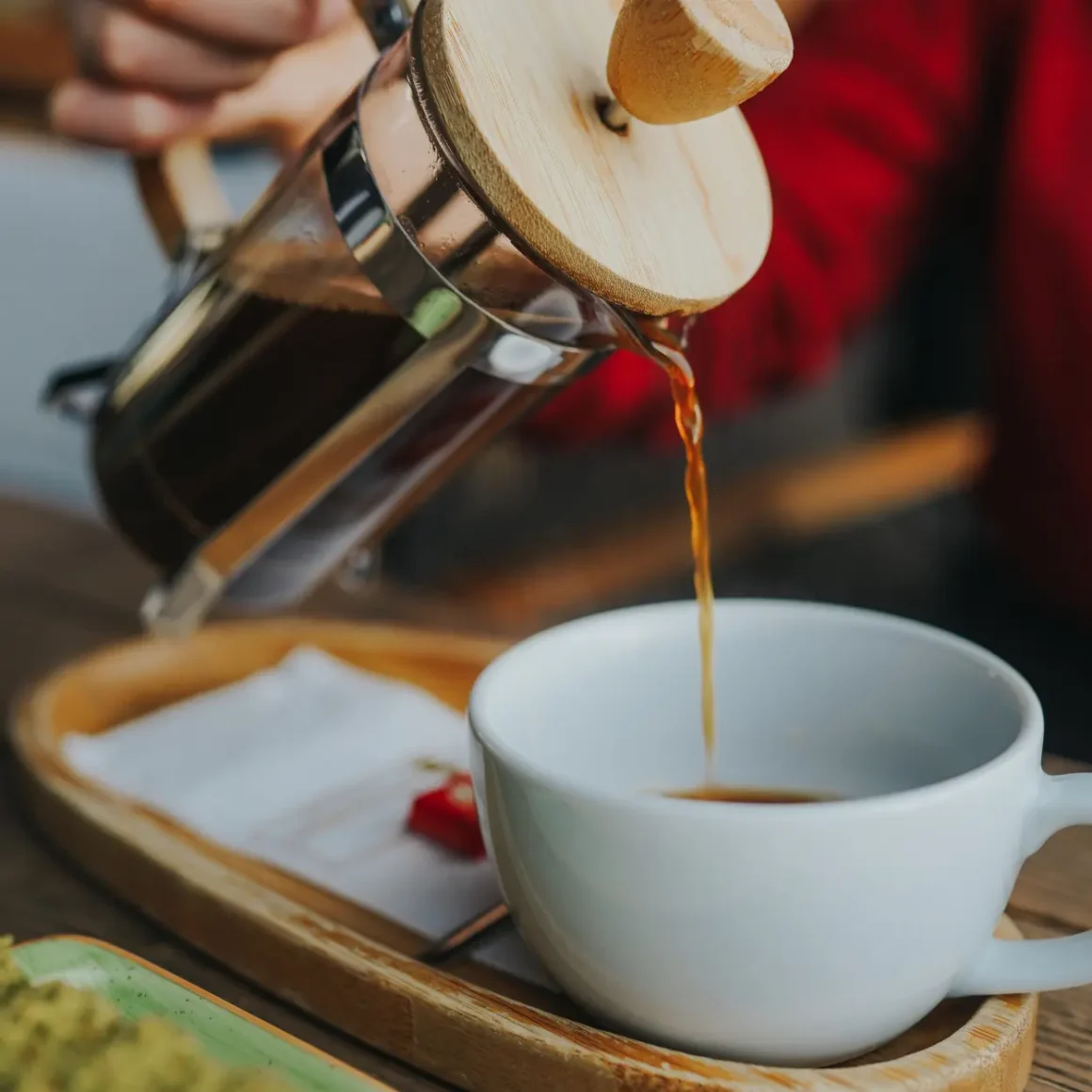
- Full-Bodied and Rich: The immersion technique of this coffee press allows coffee grounds to steep directly in hot water, ensuring that the flavors are entirely extracted. This results in a full-bodied brew, capturing the essence of every coffee particle.
- Coffee Oils: One of the defining characteristics of this coffee maker is the presence of coffee oils in the final cup. Unlike methods that use paper filters, which absorb these oils, the coffee press’s metal mesh allows them to pass through. These oils contribute to a richer flavor and a unique aromatic profile, enhancing notes that might be subdued in other brewing methods.
- Sediment: A trademark of this coffee press method is the slight sediment that often settles at the bottom of the cup. This is due to the coarser grind required for this brewing method and the mesh filter allowing finer particles through. While some enthusiasts appreciate this texture, believing it adds depth to the coffee, others might find it less appealing.
In essence, when comparing Moka Pot vs French Press, it’s a journey through contrasting landscapes of flavor and aroma. While the Moka Pot offers a bold, espresso-like experience, the French Press leans towards a more aromatic, oil-rich brew. The choice between them often rests on individual palates and the coffee adventure one wishes to embark upon.
Moka Pot vs French Press: Brewing Tips
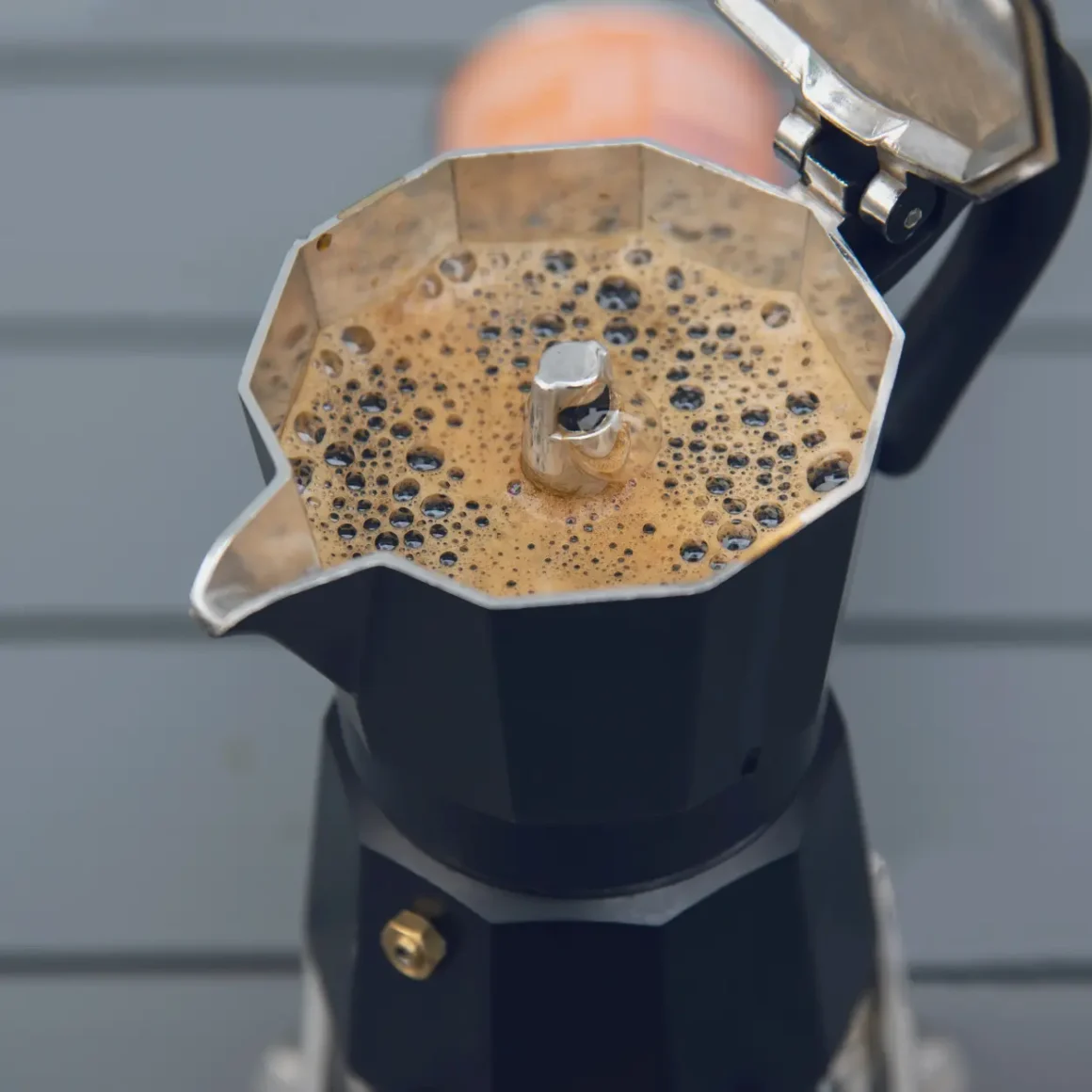
Mastering the art of brewing coffee often depends on the nuances of technique. Whether you’re working with a Moka Pot or a French Press, understanding the subtleties can transform an ordinary cup of coffee into an extraordinary one. Here, we delve into the best practices for both methods, ensuring you get the most flavor-packed brew every time.
Moka Pot Brewing Tips
Brewing coffee with a Moka Pot involves a few key considerations to achieve the best results:
- Grind Size: Use a coffee grind size between sea salt and table salt for optimal results. Too coarse can lead to weak coffee, while too fine can cause over-extraction or a burnt taste.
- Water Temperature: Preheat the water just below boiling before adding it to the Moka Pot to avoid overcooking the coffee. This reduces the chances of a burnt flavor.
- Tamping: Avoid tamping down the grounds; instead, fill the filter basket evenly and level off without pressing. This ensures consistent water flow and flavor extraction.
French Press Brewing Tips
Achieving the perfect French Press coffee requires attention to detail:
- Coffee-to-Water Ratio: Experiment with coffee-to-water ratios to find your preferred strength. A common starting point is 1 to 2 tablespoons of coffee for every 6 ounces of water.
- Steeping Time: The general recommendation for steeping in this coffee press is around 4 minutes. However, this can be adjusted based on the French press grind size and personal preference. Coarser grinds may require longer steeping, while finer grinds need less time.
- Plunge Slowly: After steeping, plunge slowly and steadily to avoid turbulence, over-extraction, and excessive sediment in your cup. A gentle press ensures a cleaner brew.
To sum it up, while both coffee makers are straightforward in design, their brewing techniques have layers of depth. By understanding and mastering these subtleties, coffee enthusiasts can ensure they extract the best flavors and aromas from their beans, elevating their daily brew to a gourmet experience.
Anatomy of a Moka Pot: Aluminum vs. Stainless Steel
The Moka Pot, celebrated for its rich and aromatic brews, is often hailed by coffee enthusiasts worldwide. When searching for the best Moka Pot, one of the primary considerations lies in the material from which it’s constructed: aluminum or stainless steel. To make an informed choice, it’s essential to understand the nuances and features of both materials.
Aluminum Moka Pots
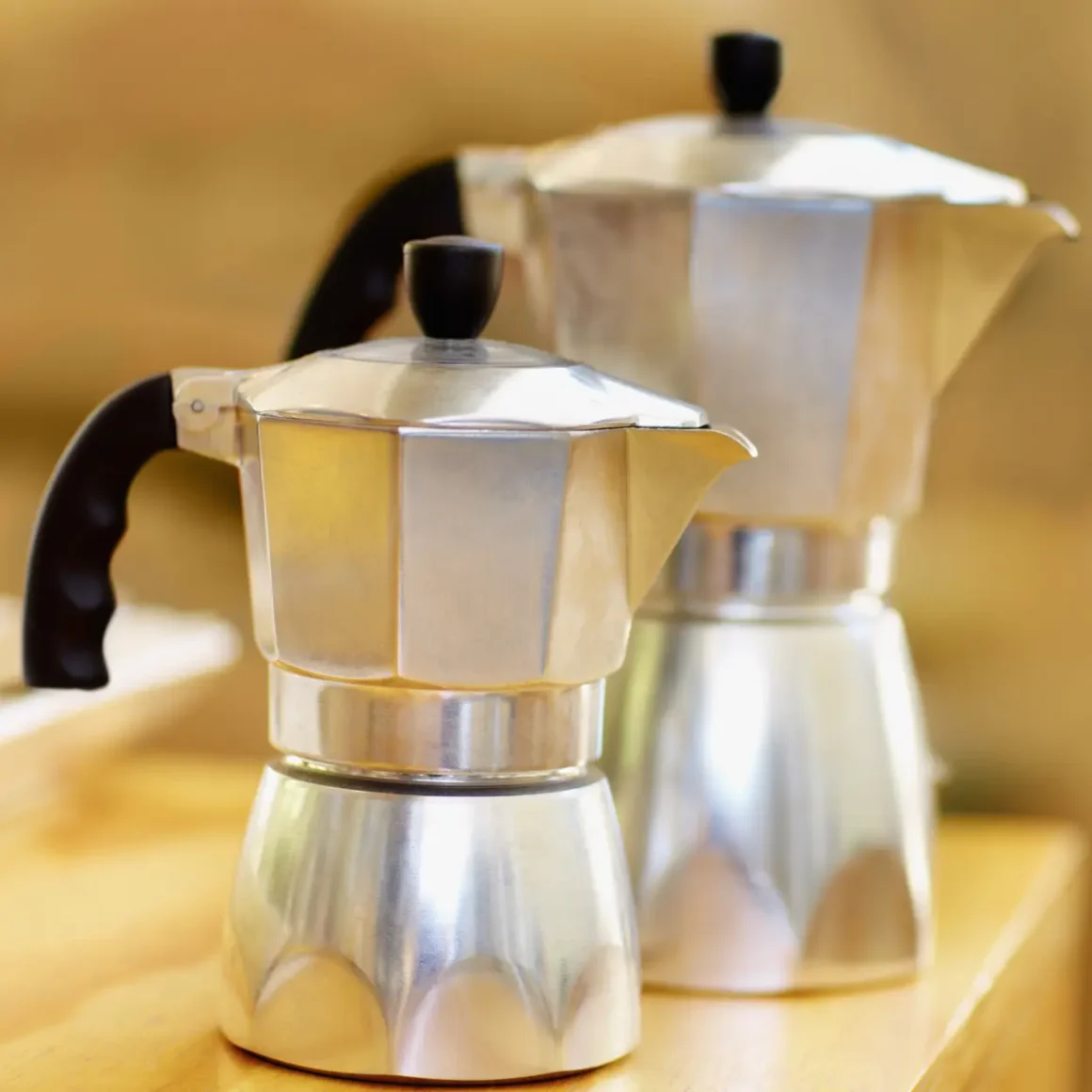
Aluminum Moka pots are a popular choice among coffee enthusiasts due to their unique properties and economic advantages. Let’s delve into the characteristics and considerations associated with these coffee makers:
- Heat Conductivity: One of aluminum’s standout properties is its excellent heat conductivity. It heats up rapidly and distributes heat evenly, ensuring that the water boils quickly and the coffee extraction is uniform.
- Weight and Portability: These pots are characteristically lightweight, making them easily portable. Whether it’s moving around the kitchen or packing for a trip, an aluminum Moka Pot is effortlessly manageable.
- Economic Advantage: Typically, aluminum variants are more cost-effective than stainless steel models. This affordability makes them accessible and a favorite among many first-time users.
- Care and Considerations: Aluminum, while robust, can be prone to oxidation if not appropriately cared for. It’s essential to dry the pot thoroughly after washing. Over time, without proper maintenance, the surface might develop a dull patina, which, while harmless, may not be aesthetically pleasing to all.
Stainless Steel Moka Pots

Stainless steel Moka pots are a favored choice among coffee connoisseurs, celebrated for their heat retention, sophisticated appearance, durability, and taste preservation. Let’s explore the distinctive features and advantages associated with these coffee makers:
- Heat Retention: Stainless steel, by nature, retains heat longer than aluminum. (3) So, while it might take a tad longer to heat up, it ensures that the coffee remains warm for an extended period post-brewing.
- Sophisticated Appearance: There’s a timeless elegance to stainless steel Moka Pots. They often feature a polished, contemporary design, making them not only brewing instruments but also stylish kitchen adornments.
- Durability Factor: Stainless steel is renowned for its resilience. Rust-resistant and less susceptible to dents and scratches compared to aluminum, it promises longevity, making it a worthwhile investment for many.
- Taste Preservation: Stainless steel doesn’t interact with the brew, ensuring that the coffee’s taste remains unaltered. For those particular about flavor integrity, stainless steel is an ideal choice.
In essence, determining the best Moka Pot material revolves around individual needs, preferences, and budget. Aluminum offers the perks of rapid heating and affordability, while stainless steel stands as a beacon of durability, aesthetics, and taste purity.
French Press Components: Glass vs. Stainless Steel
The French Press, a beloved manual coffee brewing method, is cherished for its simplicity and the rich brew it produces. A pivotal aspect of this brewing device is the material from which it’s constructed. The two predominant choices when it comes to the press pot components are glass and stainless steel. By understanding the characteristics of both materials, one can make an informed decision tailored to their brewing preferences and lifestyle.
Glass French Press
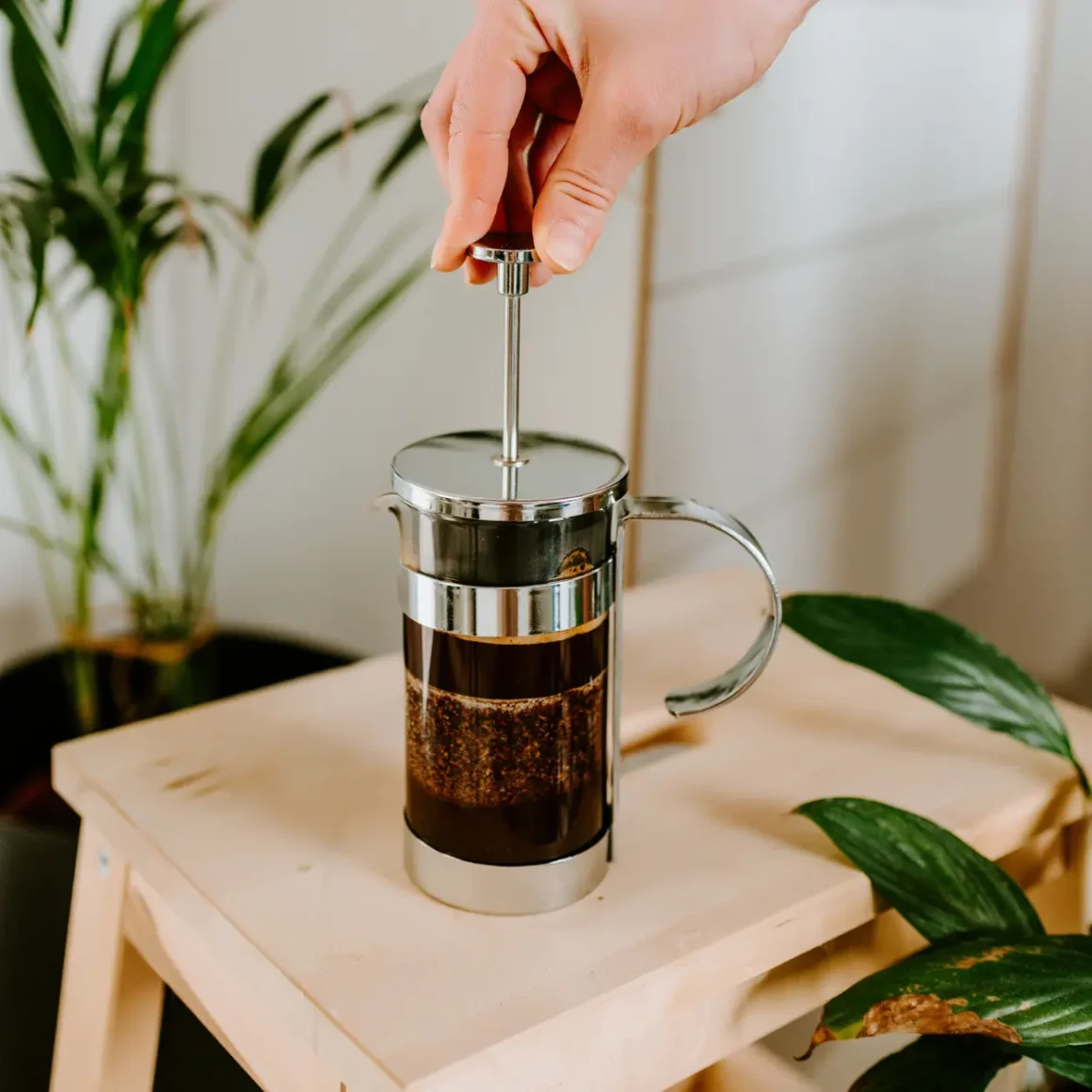
A glass press pot is a unique and visually captivating coffee brewing device that offers transparency, aesthetics, and certain considerations. Let’s explore the characteristics and aspects associated with glass French Press coffee makers:
- Transparency: One of the most distinctive features of a glass French Press is its transparency. This allows users to observe the brewing process in real time, from the initial pour to the final plunge. Watching the coffee grounds swirl and steep can be both mesmerizing and helpful in gauging the brew’s progress.
- Aesthetics: A glass French Press often exudes an elegant and classic look, making it a beautiful centerpiece on any breakfast table or coffee nook.
- Heat Retention: While glass retains heat reasonably well, especially borosilicate glass variants, it may not keep the coffee hot for extended periods compared to stainless steel.
- Durability Concerns: Glass, even when it’s the toughened variety like borosilicate, is still susceptible to breakage from accidental knocks or drops. This demands a gentle touch and careful handling.
Stainless Steel French Press:
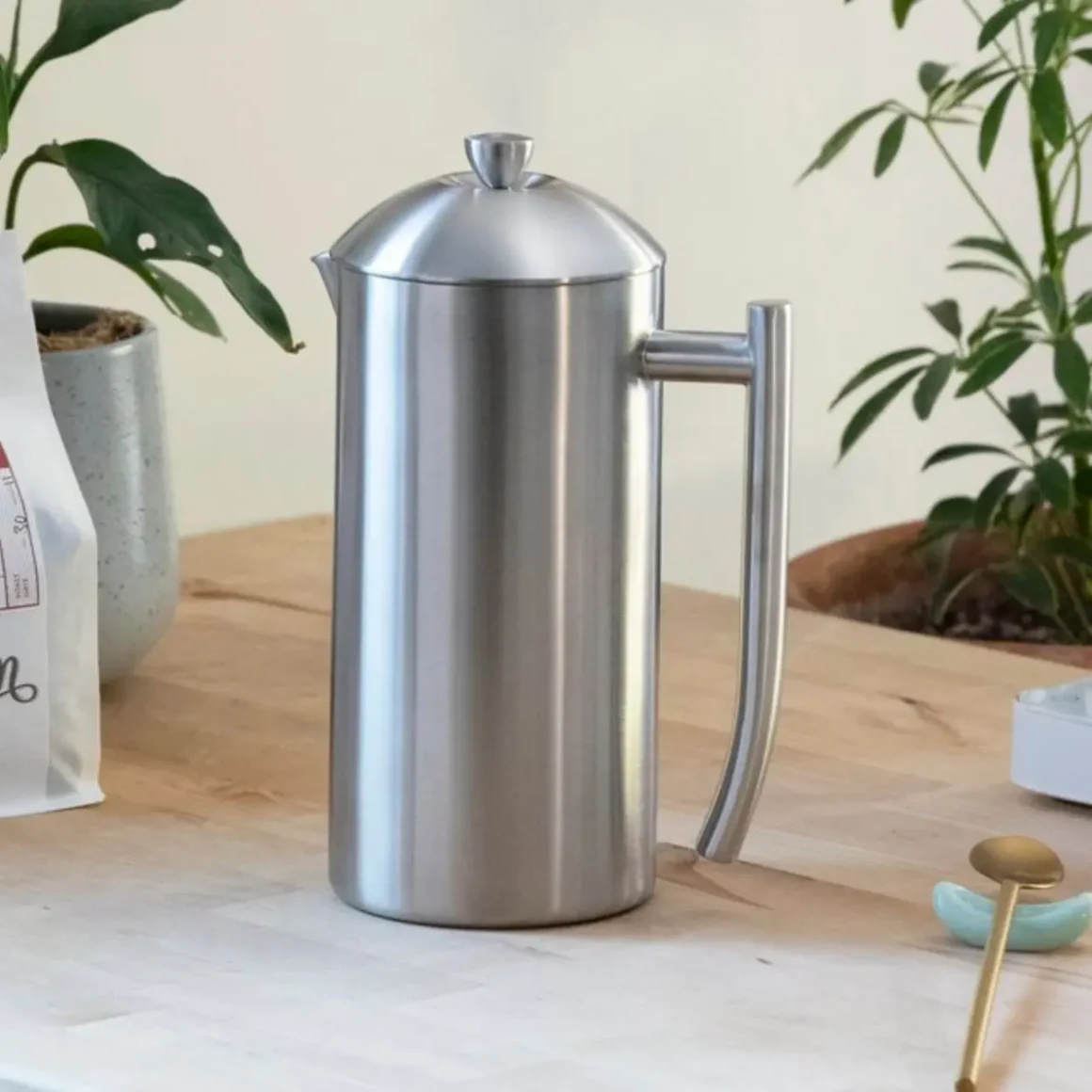
A stainless steel press pot is a remarkable coffee brewing device that offers exceptional heat insulation, robustness, modern appeal, and flavor preservation. Let’s delve into the characteristics and advantages associated with stainless steel French Press coffee makers:
- Heat Insulation: Stainless steel inherently possesses superior heat-retention capabilities. This means that a stainless steel French Press can keep coffee hotter for longer, perfect for those who like to savor their brew over extended periods.
- Robustness: Durability is one of the prime advantages of stainless steel. It’s resistant to breaks, cracks, and dents, making it ideal for frequent use, travel, or households where accidents might happen.
- Modern Appeal: With its sleek and contemporary design, a stainless steel press pot adds a touch of modernity to any kitchen setting.
- Flavor Preservation: Stainless steel is neutral and won’t interfere with the coffee’s natural flavors, ensuring a pure and unaltered taste in every cup.
Overall, the choice between glass and stainless steel in a press pot revolves around aesthetics, functionality, and durability preferences. While glass offers visual appeal and brewing transparency, stainless steel stands out for its robustness and heat retention. Making an informed decision between the two ensures that each brew is not only flavorful but also an experience in itself.
Care and Longevity: Tips for a Lasting Coffee Relationship
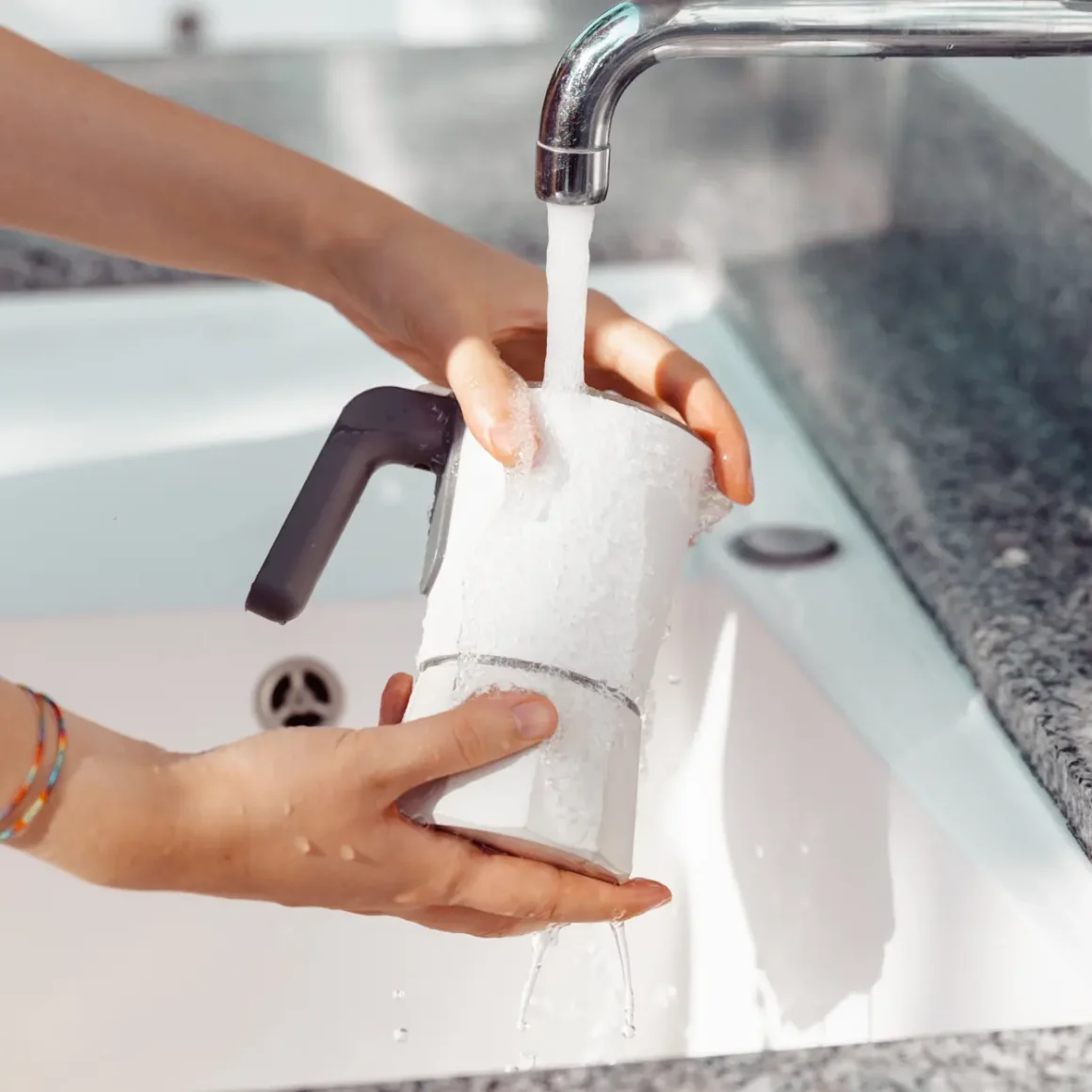
A lasting bond with your coffee equipment ensures many memorable brews over the years. Just like any meaningful relationship, the alliance between a coffee enthusiast and their equipment requires attention, understanding, and care. Adopting practices to maintain and extend the life of your brewing devices is the key to consistently great coffee and a prolonged relationship with your cherished equipment.
General Care Tips
Proper care and maintenance are crucial for the longevity and performance of your coffee brewing equipment. Whether you have a French press or Moka pot, here are essential care tips to keep in mind:
- Regular Cleaning: The essence of equipment longevity lies in routine cleaning. Ensuring that your brewing device, be it a French press or Moka pot is free of old coffee grounds and oils after each use, will maintain its functionality and prevent unwanted flavors in future brews.
- Descale Periodically: Mineral deposits from water can build up over time, affecting performance and taste. Using a descaling solution or a simple white vinegar and water mixture every few months helps in removing these deposits, especially in machines.
- Dry Thoroughly: Post-cleaning, it’s vital to ensure all parts are dried properly, especially those with metal components. This prevents corrosion, mold, and unpleasant odors.
- Handle with Care: While this might sound straightforward, being gentle during use and cleaning can extend the life of your equipment. This is especially true for devices with glass or fragile components.
Storage and Usage
Effective storage and proper usage practices are essential to ensure the longevity and performance of your coffee equipment. Whether you have a Moka pot or French Press, consider the following tips:
- Proper Storage: Store your equipment in a cool, dry place. Avoiding direct sunlight or areas with drastic temperature fluctuations can prevent premature wear and tear.
- Follow Manufacturer Guidelines: Always refer to the manufacturer’s instructions regarding usage and care. They provide insights tailored to the specific design and materials of the product.
- Replace Parts as Needed: Over time, some parts like seals, gaskets, or filters might wear out. Instead of replacing the entire device, consider sourcing these parts and replacing them. This not only saves money but also demonstrates a commitment to sustainability.
In summary, fostering a lasting coffee relationship demands a balance of regular maintenance, understanding the needs of your equipment, and timely interventions.
Moka Pot vs French Press: Making Your Choice
Coffee, with its myriad brewing methods, offers a range of experiences to suit every palate. When faced with choices like the French press vs Moka pot, or myriad other options, how does one decide? Making an informed choice is pivotal, ensuring that each cup you brew aligns perfectly with your expectations. Let’s delve into the factors and considerations that can guide you towards your perfect brew.
Factors to Consider
Choosing between a Moka Pot and a French Press requires more than just understanding the basics of each method. It’s about diving into the intricate details and aligning them with your personal preferences and lifestyle. Here’s a closer look at some of the key factors to ponder:
Flavor Preference:
- French Press: Known for producing a full-bodied brew, allowing the natural oils and subtle flavors of the coffee to shine through. If you’re looking for the best coffee for French press, opt for coarser grinds that suit this method.
- Moka Pot: Delivers a bold and concentrated coffee, often compared to espresso. It accentuates the deeper notes of the coffee beans.
Brewing Time:
- French Press: Generally takes about 4-5 minutes of steeping time after boiling the water.
- Moka Pot: While the time can vary depending on the heat source and pot size, a Moka pot usually takes 5-10 minutes from start to finish
Portability and Travel: On-the-Go Coffee Solutions:
- French Press: While traditional glass French presses aren’t always travel-friendly, there are compact, plastic, or stainless steel variants perfect for the on-the-go.
- Moka Pot: The smaller aluminum models are relatively lightweight and durable, making them suitable for travel.
Choosing the Right Brewing Method for You
The quest for the perfect cup of coffee is as much about personal preference as it is about technique. When it comes to these brewing techniques, both have their merits and intricacies. Delve into the characteristics of each to determine which aligns best with your brewing style, preferences, and needs:
Batch Sizes: From Solo Mornings to Social Gatherings:
- French Press: Comes in various sizes, from single servings to larger pots that can serve a group. It’s great for brewing a larger batch at once.
- Moka Pot: While it does come in different sizes, each brew generally serves 1-6 cups, making it ideal for solo or small group servings.
Learning Curve: Ease of Use for Beginners:
- French Press: One of the most beginner-friendly methods. The steps are straightforward, and there’s little that can go wrong.
- Moka Pot: Requires a bit more attention to detail, especially with water level and grind size, but with practice, it becomes second nature.
Common Mistakes to Avoid:
- French Press: Not using a coarse grind can lead to over-extraction or a muddy brew. Additionally, not plunging slowly or evenly can affect the brew’s consistency.
- Moka Pot: Using the wrong grind size or overfilling/underfilling the chambers can result in poor extraction. It’s also crucial to avoid using extremely high heat, as this can give the coffee a burnt taste.
Conclusion
In the endearing journey of “Moka Pot vs French Press: A Coffee Lover’s Dilemma,” we’ve brewed, sipped, and savored the unique attributes of both methods. Each offers a distinct flavor profile, brewing experience, and a touch of tradition. The choice between French press vs Moka pot is less about superiority and more about personal preference. Whether you lean towards the full-bodied immersion of the press pot or the bold intensity of the Moka pot, remember that the best method is the one that aligns with your taste and brewing ritual. Whichever path you choose, may every cup bring you closer to coffee nirvana.
Other Coffee Brewing Equipment Comparisons
- Moka Pot vs Nespresso: A Comparative Guide
- Hario V60 vs Kalita Wave: Which Pour-Over Coffee Maker Is Right for You?
- Chemex vs V60: Which Coffee Maker is Better for You?
- Pour Over vs Espresso: A Comprehensive Comparison
- Moka Pot vs Espresso Machine: Exploring the Key Differences
FAQ
Can I use pre-ground coffee in both the Moka Pot and French Press?
Yes, but ensure the grind size suits the brewing method: finer for Moka Pot and coarser for French Press.
What is the main difference in flavor between Moka Pot and French Press coffee?
Moka Pot coffee is bold and concentrated, akin to espresso, while French Press coffee is full-bodied with a rich flavor profile.
Is one method more suitable for travel or camping?
Moka Pots, especially the smaller aluminum variants, are more lightweight and durable, making them slightly more suitable for travel or camping.
Are there any safety precautions to consider when using a Moka Pot or French Press?
For Moka Pots, ensure the valve isn't blocked and avoid overfilling; with French Presses, be gentle while plunging to prevent glass breakage or hot liquid spillage.
